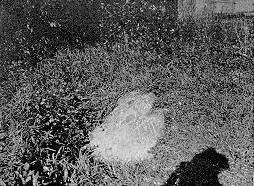1638 – HAMPTON TERCENTENARY – 1938
Thorvald
By William D. Cram
In absorbing accounts of the Icelandic Sagas (which those interested will find in the first few pages of Vol. 43 of Eliot’s Harvard Classics) is given the story of Leif Ericsson’s discovery of North America. Leif did not keep secret his discovery. He told many others who sailed along these shore landing here and there and from Labrador to New Jersey are reported findings of marks and carvings which are claimed to be those of the Norse or Icelandic people, Runic inscriptions. After Leif’s brother, Thornstein, had made a futile attempt to find the place, another brother, Thorvald, started on the same quest. Wintering at the place Leif had given the name Wineland or Vinland, the next spring Thorvald and his men started further exploration of the coast. After visiting various places and meeting with many experiences he finally sighted the point which local historians and students claim was Great Boar’s Head.
It has been visited and examined by thousands, including the most distinguished archaeologists of this country and Europe, and none of these who are the best qualified to judge, doubt its authenticity. It seems strange the State or Nation does not take some action to protect and preserve this ancient monument, which for 900 years has marked the grave of the first European buried on the American continent.
Fair indeed must have been this headland with its covering of great, beautiful pines, extending in that year of 1003 many hundred feet farther into the sea than it does today. Attractive, too, were its surroundings. It was summer. In fact it must have made a wonderful picture to cause Thorvald, after his passing up and down the shore, to exclaim, “It is a fair region here, and here I should like to make my home.” From here we quote the Saga, “…… a headland which projected into the sea there, and which was entirely covered with woods. They found a anchorage for their ship, and put out the gangway to the land and Thorvald and his companions went ashore. When they returned to their ship they discovered on the sands, in beyond the headland, three mounds: they went up to these, and saw that they were three skin canoes with three men under each. They thereupon divided their party, and succeeded in seizing all the men but one, who escaped in his canoe. They killed the eight men, and then ascended the headland again, and looked about them, and discovered within the firth certain hillocks, which they concluded must be habitations. They were then so overpowered with sleep they could not keep awake, and fell into a (heavy) slumber from which they were awakened by the sound of a cry uttered above them; and the words of the cry were these: ‘Awake, Thorvald, thou and all thy company, if thou wouldst save thy life; and board thy ship with all thy men and sail with all speed from the land.’
A countless number of skin canoes then advanced toward them from the inner part of the firth, whereupon Thorvald exclaimed, ‘We must put out the war-boards on both sides of the ship, and defend ourselves to the best of our ability, but offer little attack.’ This they did; and the skrellings, after they had shot at them for a time fled precipitately, each as best he could. Thorvald then inquired of his men whether any of them had been wounded, and they informed him that no one of them had received a wound. ‘I have been wounded in my arm-pit,’ says he, ‘An arrow flew in between the gunwale and the shield, below my arm. Here is the shaft, and it will bring me to my end. I counsel you now to retrace your way with the utmost speed but me ye shall convey to the headland which seemed to me to offer so pleasant a dwelling-place; thus it may be fulfilled that the truth sprang to my lips when I expressed the wish to abide there for a time. Ye shall bury me there, and place a cross at my head, and another at my feet, and call it Crossness forever after.’ …… Thorvald died; and when they had carried out his injunctions, they took their departure ….. to recount great tidings to Leif.”
It would seem, however, that because of the fact that some Indians had habitations on Great Boar’s Head, Thorvald was buried about half a mile away where they thought the burial would be unobserved and where the combination of an open space of a small area prevented the necessity of felling trees, and where conveniently some glacial rocks had been deposited thus saving them not only labor but also from leaving any trail of movement for the Indians to notice. To complete the secrecy of the burial place, the stone was left embedded in the ground and every effort made to conceal the fact of the burial from the natives.
Unknown to them, Indians with keen eyes and ears had followed them remaining hidden among the trees and shrubs, watching the burial. And what they saw with other tribal tales of the acts of the white strangers was handed down through generation after generation.
